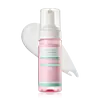What's inside
What's inside
 Key Ingredients
Key Ingredients

 Benefits
Benefits

 Concerns
Concerns

 Ingredients Side-by-side
Ingredients Side-by-side

Water
Skin ConditioningGlycerin
HumectantDisodium Cocoamphodiacetate
Cleansing1,2-Hexanediol
Skin ConditioningSodium Chloride
MaskingPolyglyceryl-10 Laurate
Skin ConditioningPotassium Cocoyl Glycinate
Sorbitol
HumectantButylene Glycol
HumectantParfum
MaskingEthylhexylglycerin
Skin ConditioningHexylene Glycol
EmulsifyingTrisodium Ethylenediamine Disuccinate
Citric Acid
BufferingNiacinamide
SmoothingPropanediol
SolventIsopentyldiol
HumectantCamellia Japonica Flower Extract
EmollientDecyl Glucoside
CleansingTrifolium Pratense Flower Extract
AstringentAloe Barbadensis Leaf Extract
EmollientCamellia Sinensis Leaf Extract
AntimicrobialCentella Asiatica Leaf Extract
Skin ConditioningGrateloupia Elliptica Extract
Skin ConditioningSalix Alba Bark Extract
AstringentBackhousia Citriodora Leaf Extract
AstringentCI 17200
Cosmetic ColorantGlycine Soja Seed Extract
Skin ConditioningBioflavonoids
Skin ConditioningCI 15985
Cosmetic ColorantCitrus Aurantium Bergamia Leaf Extract
AstringentBrassica Oleracea Italica Extract
AstringentCalamine
AbsorbentPinus Sylvestris Leaf Extract
TonicWater, Glycerin, Disodium Cocoamphodiacetate, 1,2-Hexanediol, Sodium Chloride, Polyglyceryl-10 Laurate, Potassium Cocoyl Glycinate, Sorbitol, Butylene Glycol, Parfum, Ethylhexylglycerin, Hexylene Glycol, Trisodium Ethylenediamine Disuccinate, Citric Acid, Niacinamide, Propanediol, Isopentyldiol, Camellia Japonica Flower Extract, Decyl Glucoside, Trifolium Pratense Flower Extract, Aloe Barbadensis Leaf Extract, Camellia Sinensis Leaf Extract, Centella Asiatica Leaf Extract, Grateloupia Elliptica Extract, Salix Alba Bark Extract, Backhousia Citriodora Leaf Extract, CI 17200, Glycine Soja Seed Extract, Bioflavonoids, CI 15985, Citrus Aurantium Bergamia Leaf Extract, Brassica Oleracea Italica Extract, Calamine, Pinus Sylvestris Leaf Extract
Water
Skin ConditioningPEG-6 Caprylic/Capric Glycerides
EmulsifyingAloe Barbadensis Leaf Extract
EmollientCucumis Sativus Fruit Extract
EmollientMannitol
HumectantXylitol
HumectantRhamnose
HumectantFructooligosaccharides
HumectantLecithin
EmollientGinkgo Biloba Leaf Extract
Skin ConditioningCamellia Sinensis Leaf Extract
AntimicrobialPropylene Glycol
HumectantDisodium EDTA
Cetrimonium Bromide
AntimicrobialSodium Hydroxide
BufferingCitric Acid
BufferingWater, PEG-6 Caprylic/Capric Glycerides, Aloe Barbadensis Leaf Extract, Cucumis Sativus Fruit Extract, Mannitol, Xylitol, Rhamnose, Fructooligosaccharides, Lecithin, Ginkgo Biloba Leaf Extract, Camellia Sinensis Leaf Extract, Propylene Glycol, Disodium EDTA, Cetrimonium Bromide, Sodium Hydroxide, Citric Acid
 Reviews
Reviews

Ingredients Explained
These ingredients are found in both products.
Ingredients higher up in an ingredient list are typically present in a larger amount.
Aloe Barbadensis Leaf Extract is an extract of the leaves of the aloe, Aloe barbadensis, Liliaceae.
Aloe is one of the most well-known natural soothing ingredients, and for good reason. It’s full of water and has a cooling, calming effect on the skin, especially when it’s sunburned, itchy, or irritated. Aloe also helps your skin stay hydrated and smooth by mimicking what healthy skin naturally produces. On top of that, it contains vitamins and nutrients that support skin recovery.
It doesn’t protect you from the sun, but it can help your skin bounce back after too much time in it.
Let’s get into the details:
Aloe contains antioxidant Vitamins A, C, and E, which help fight off free radicals (unstable molecules from things like pollution that can damage your skin).
It’s also rich in polysaccharides, which are natural sugars that help hydrate the skin by acting like the skin’s own moisturizing agents. These, along with other sugars like monosaccharides, help form a protective barrier that locks in moisture.
Aloe works as both a humectant and an emollient. That means it draws water into the skin (humectant) and helps trap it there (emollient), making it an effective natural moisturizer.
You’ll also find a mix of other skin-supporting ingredients in aloe, including folic acid, choline, calcium, amino acids, fatty acids, and even Vitamin B12.
Out of the 420+ species of aloe, Aloe barbadensis is the most widely used in skincare products thanks to its gentle yet effective properties.
There are over 420 species of aloe but Aloe Barbadensis is the most commonly used for topical products.
Learn more about Aloe Barbadensis Leaf ExtractCamellia Sinensis Leaf Extract is derived from the leaves of the tea plant. Black tea, green tea, and oolong tea are all harvested from this plant.
This ingredient has many skin benefits:
This ingredient contains polyphenols, a strong antioxidant. Antioxidants help fight off molecules that damage skin cells.
On top of that, the antioxidants in green tea neutralize free-radicals from the sun. This gives the skin some extra UV protection, but should not replace sunscreen.
Many components of tea have anti-inflammatory properties.
Polyphenols and L-theanine help soothe the skin and reduce irritation. The caffeine in Camellia Sinensis Leaf Extract helps calm inflamed blood vessels.
Other compounds found in tea include: Vitamin Bs, linoleic acid, magnesium, calcium, iron, and zinc.
Research has shown both drinking Camellia Sinensis Leaf Tea and applying it to the skin can help boost skin elasticity and hydration. Studies also show using tea extract may reduce sebum, or oil, production.
Learn more about Camellia Sinensis Leaf ExtractCitric Acid is an alpha hydroxy acid (AHA) naturally found in citrus fruits like oranges, lemons, and limes.
Like other AHAs, citric acid can exfoliate skin by breaking down the bonds that hold dead skin cells together. This helps reveal smoother and brighter skin underneath.
However, this exfoliating effect only happens at high concentrations (20%) which can be hard to find in cosmetic products.
Due to this, citric acid is usually included in small amounts as a pH adjuster. This helps keep products slightly more acidic and compatible with skin's natural pH.
In skincare formulas, citric acid can:
While it can provide some skin benefits, research shows lactic acid and glycolic acid are generally more effective and less irritating exfoliants.
Most citric acid used in skincare today is made by fermenting sugars (usually from molasses). This synthetic version is identical to the natural citrus form but easier to stabilize and use in formulations.
Read more about some other popular AHA's here:
Learn more about Citric AcidWater. It's the most common cosmetic ingredient of all. You'll usually see it at the top of ingredient lists, meaning that it makes up the largest part of the product.
So why is it so popular? Water most often acts as a solvent - this means that it helps dissolve other ingredients into the formulation.
You'll also recognize water as that liquid we all need to stay alive. If you see this, drink a glass of water. Stay hydrated!
Learn more about Water